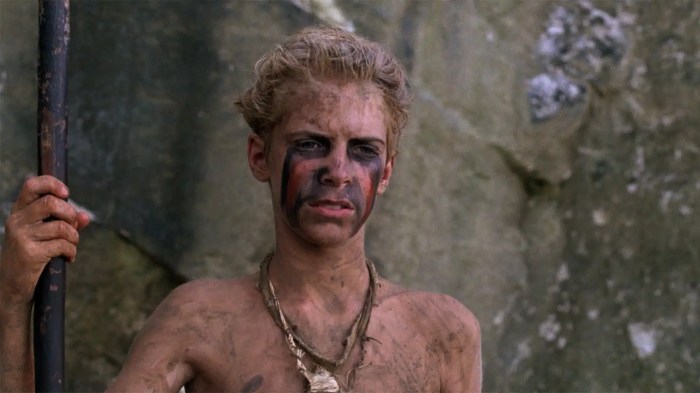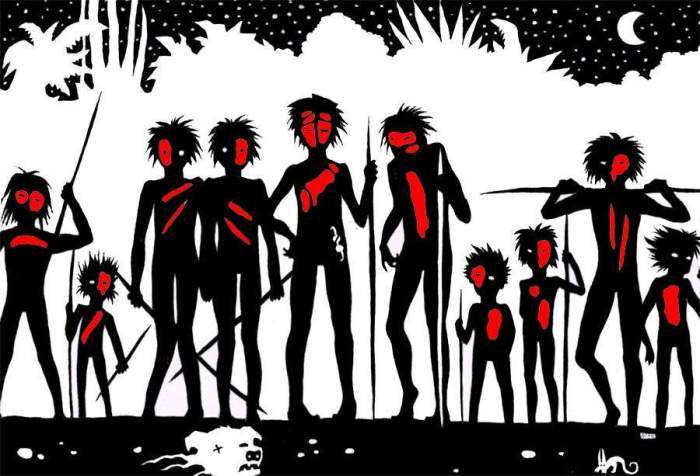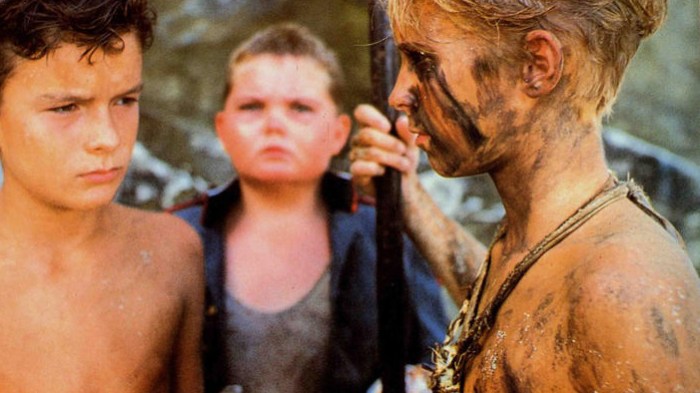Lord of the flies the animal within – Lord of the Flies: The Animal Within delves into the depths of human nature, exploring the conflict between civilization and savagery through the lens of a group of boys stranded on a deserted island. This thought-provoking novel by William Golding offers a profound examination of the fragility of human society and the darkness that lurks within us all.
As the boys descend into savagery, the novel raises questions about the nature of good and evil, the power of fear and violence, and the limits of human reason. Through the characters of Piggy and Simon, Golding presents a poignant exploration of the struggle to maintain order and morality in the face of adversity.
Lord of the Flies

William Golding’s Lord of the Fliesis a seminal work of literature that delves into the inherent duality of human nature, exploring the tension between civilization and savagery. The novel depicts a group of British schoolboys stranded on a remote island after a plane crash, and their gradual descent into chaos and violence.
Themes of Savagery and Civilization
The novel’s central theme revolves around the conflict between the boys’ innate savagery and their veneer of civilization. Initially, the boys attempt to maintain order and establish a society based on the rules and values they learned in their previous lives.
However, as their isolation prolongs, the constraints of civilization begin to crumble, revealing the underlying savagery within them.
- The Descent into Savagery:As the boys succumb to their primal instincts, they engage in increasingly violent and barbaric behavior, forming factions and engaging in hunting and warfare.
- The Failure of Civilization:The boys’ attempts to establish a democratic society fail due to their inability to control their impulses and their susceptibility to fear and superstition.
- The Role of the Beast:The boys’ fears manifest in the form of a mythical beast that they believe inhabits the island, symbolizing the destructive potential of their own savage nature.
The Boys’ Descent into Savagery
The boys in Lord of the Fliesundergo a gradual descent from civilized behavior to savagery. This transformation is driven by a number of factors, including fear, hunger, and isolation.
Initially, the boys attempt to maintain a semblance of order and civilization. They elect a leader, Ralph, and establish rules and rituals. However, as the boys become increasingly isolated and their resources dwindle, they begin to regress to more primitive behaviors.
Fear
Fear is a powerful force that drives the boys’ descent into savagery. The boys are constantly afraid of the unknown, both on the island and within themselves. This fear leads them to make irrational decisions and to lash out at others.
Hunger
Hunger is another factor that contributes to the boys’ savagery. The boys are constantly hungry, and this hunger makes them desperate. They are willing to do anything to get food, even if it means resorting to violence.
Isolation
The boys’ isolation on the island also plays a role in their descent into savagery. The boys are cut off from the rest of society, and this isolation leads them to lose their sense of morality and empathy.
The Role of Piggy and Simon
Piggy and Simon are two characters in William Golding’s novel “Lord of the Flies” who represent reason and morality. Piggy is an overweight, asthmatic boy who is often ridiculed by the other boys. However, he is also intelligent and resourceful, and he tries to maintain order on the island.
Simon is a quiet, sensitive boy who is in tune with nature. He is the first to realize that the island is not a paradise, but a place of darkness and danger.Piggy and Simon’s struggles to maintain order on the island are ultimately unsuccessful.
The other boys, led by the charismatic Jack, become increasingly savage and violent. Piggy is killed by Roger, a member of Jack’s tribe, and Simon is killed by the other boys in a frenzied ritual.The deaths of Piggy and Simon symbolize the failure of reason and morality on the island.
The boys have descended into savagery, and there is no hope for them to return to civilization.
Piggy: The Voice of Reason
Piggy is the only boy on the island who consistently tries to maintain order and reason. He is intelligent and resourceful, and he understands the importance of rules and laws. However, he is also overweight and asthmatic, which makes him a target for ridicule from the other boys.Despite
his physical weaknesses, Piggy is a strong and determined character. He stands up to Jack and his tribe, even when it is clear that he will be outnumbered and outmatched. He believes that there is still hope for the boys to return to civilization, and he refuses to give up on them.Piggy’s
death is a tragic loss for the boys. He is the only one who truly understands the importance of reason and morality, and his death symbolizes the failure of those values on the island.
Simon: The Voice of Morality
Simon is a quiet, sensitive boy who is in tune with nature. He is the first to realize that the island is not a paradise, but a place of darkness and danger. He also understands the importance of compassion and empathy, and he tries to help the other boys to see the error of their ways.Simon’s
attempts to reason with the other boys are unsuccessful. They are too caught up in their own savagery to listen to him. He is eventually killed by the other boys in a frenzied ritual, which symbolizes the failure of morality on the island.Simon’s
death is a tragic loss for the boys. He is the only one who truly understands the importance of compassion and empathy, and his death symbolizes the failure of those values on the island.
The Symbolism of the Beast
The Beast in Lord of the Fliesserves as a multifaceted symbol, embodying the latent darkness lurking within the hearts of the boys and representing the primal instincts that threaten to consume them.
The Beast manifests itself in various forms throughout the novel. Initially, it is perceived as an external threat, a mysterious creature that haunts the island and instills fear in the boys. However, as the story progresses, it becomes increasingly clear that the Beast is not merely an external force but a reflection of the boys’ own savagery and moral decay.
The Beast as Inner Darkness
The Beast represents the uncivilized, violent, and destructive impulses that lie dormant within all human beings. It is the embodiment of the id, the primitive part of the psyche that seeks immediate gratification and acts on instinct.
As the boys succumb to their primal instincts, the Beast gains power. It manifests itself through acts of violence, such as the killing of Simon and Piggy, and through the establishment of a reign of terror on the island.
The Beast as the Breakdown of Civilization
The Beast also symbolizes the breakdown of civilization and the loss of innocence. As the boys descend into savagery, the rules and morals that once governed their behavior disintegrate, and the Beast takes hold.
The island itself becomes a microcosm of the wider world, reflecting the dangers of unchecked violence and the fragility of civilization.
The Beast as a Catalyst for Redemption
Paradoxically, the Beast can also be seen as a catalyst for redemption. Through its destructive force, it forces the boys to confront their own darkness and to seek a path back to civilization.
The death of Piggy, a symbol of reason and order, serves as a wake-up call for the boys. They realize the true extent of their savagery and the need to reclaim their humanity.
The Ending of the Novel
The novel’s conclusion is marked by a series of dramatic events that bring the boys’ descent into savagery to a climax. As the group splits into two factions, Ralph and Piggy find themselves isolated and hunted by Jack and his tribe.
A violent confrontation ensues, resulting in Piggy’s brutal murder and the destruction of the conch shell, the symbol of civilization.
Ralph’s Escape and the Arrival of the Naval Officer
In the midst of the chaos, Ralph manages to escape and encounters a British naval officer who has arrived on the island. The officer represents the return of adult authority and the restoration of order. His presence highlights the contrast between the boys’ savagery and the civilized world they have left behind.
The Implications of the Ending
The novel’s ending underscores the fragility of civilization and the ease with which it can collapse in the absence of strong leadership and moral values. The boys’ transformation from innocent children into ruthless savages demonstrates the inherent darkness that lurks within human nature.
Moreover, the destruction of the conch shell symbolizes the loss of hope and the triumph of barbarism.
The novel also suggests that the veneer of civilization is thin and easily shattered. When faced with adversity, even those who initially adhere to moral principles can succumb to their primal instincts. The boys’ experience on the island serves as a cautionary tale about the dangers of unchecked power and the importance of maintaining a moral compass.
Themes and Motifs
William Golding’s Lord of the Fliesexplores profound themes and motifs that delve into the complexities of human nature and society. The novel highlights the fragile balance between civilization and savagery, the darkness that lurks within us, and the devastating consequences of fear and violence.
The Conflict between Civilization and Savagery
Lord of the Fliesvividly depicts the tension between the veneer of civilization and the primal instincts of savagery. When a group of British schoolboys is stranded on a deserted island, they initially attempt to maintain order and establish rules. However, as time passes, their civilized facade crumbles, revealing the savagery that lies beneath the surface.
- The Conch:The conch symbolizes the fragile authority of civilization. Initially, it is used to call assemblies and maintain order, but its power diminishes as the boys descend into chaos.
- The Fire:The fire represents both the hope and the destructive potential of human nature. It provides warmth and comfort, but it also becomes a symbol of violence and destruction.
The Fragility of Human Nature
The novel explores the fragility of human nature and the ease with which it can succumb to evil. Even the most innocent of children are capable of great cruelty and violence when stripped of the constraints of society.
- Jack Merridew:Jack represents the savage instincts that lie within all humans. He is charismatic and persuasive, but he also embodies the destructive power of unchecked ambition.
- Simon:Simon is a visionary who recognizes the darkness within himself and others. He is ultimately killed by the other boys, symbolizing the triumph of savagery over innocence.
The Power of Fear and Violence
Lord of the Fliesdemonstrates the devastating consequences of fear and violence. Fear drives the boys to irrational and cruel acts, while violence becomes a self-perpetuating cycle that destroys both individuals and the community.
- The Beast:The Beast represents the primal fears that haunt the boys. It is both a physical threat and a symbol of the darkness within them.
- The Lord of the Flies:The Lord of the Flies is a demonic figure who tempts the boys with violence and savagery. It symbolizes the evil that resides in the human heart.
Character Analysis

William Golding’s Lord of the Fliespresents a profound exploration of human nature through a group of young boys stranded on a deserted island. Each character embodies distinct traits and motivations, contributing to the complex dynamics of the group.
Ralph, Lord of the flies the animal within
Ralph emerges as the natural leader, embodying order, reason, and civilization. His physical strength, charisma, and innate sense of responsibility drive him to maintain peace and unity among the boys. However, his idealism and reliance on rules often clash with the darker impulses of his companions.
Jack
Jack represents the primal instincts and savage impulses that lie beneath the veneer of civilization. His charismatic and assertive nature masks a ruthless ambition and a lust for power. As the leader of the hunters, he embraces violence and savagery, gradually leading the boys down a path of destruction.
Piggy
Piggy, the intellectual and rational voice of the group, is marginalized and ridiculed due to his physical appearance and intelligence. Despite his physical weakness, Piggy’s intelligence and common sense provide a beacon of hope in the midst of chaos. However, his inability to conform to the dominant culture ultimately leads to his tragic demise.
Simon
Simon embodies spiritual insight and the ability to connect with the island’s primal forces. He possesses a deep understanding of the boys’ inner turmoil and the fragility of their civilization. However, his mystical and enigmatic nature alienates him from the others, making him an outsider in their savage world.
Roger
Roger represents the embodiment of pure evil and violence. He delights in inflicting pain and suffering on others, reveling in the chaos and destruction that surrounds him. Roger’s sadistic nature serves as a constant reminder of the dark potential that lurks within human nature.
Critical Reception

Lord of the Fliesreceived widespread critical acclaim upon its release in 1954. Critics praised Golding’s exploration of human nature, his vivid prose, and his insightful depiction of the descent into savagery.
The novel has had a profound impact on literature, inspiring numerous adaptations and interpretations. It has been translated into more than 30 languages and has sold millions of copies worldwide. Lord of the Fliesis considered a classic of modern literature and is frequently taught in schools and universities.
Legacy and Enduring Influence
Lord of the Flieshas had a lasting impact on literature and culture, inspiring countless works of art, literature, and film.
- Literary Adaptations:The novel has been adapted into several films, television series, and stage plays, including a notable 1963 film adaptation directed by Peter Brook.
- Artistic Influence:The novel’s themes and imagery have influenced artists across various disciplines, including painters, sculptors, and musicians.
- Cultural Impact: Lord of the Flieshas become a cultural touchstone, with its themes and characters referenced in popular culture, politics, and philosophy.
Top FAQs: Lord Of The Flies The Animal Within
What is the main theme of Lord of the Flies: The Animal Within?
The main theme is the conflict between civilization and savagery, and the fragility of human nature.
Who are the main characters in Lord of the Flies: The Animal Within?
The main characters are Ralph, Jack, Piggy, and Simon.
What is the significance of the Beast in Lord of the Flies: The Animal Within?
The Beast represents the boys’ inner darkness and the savagery that lurks within them.
